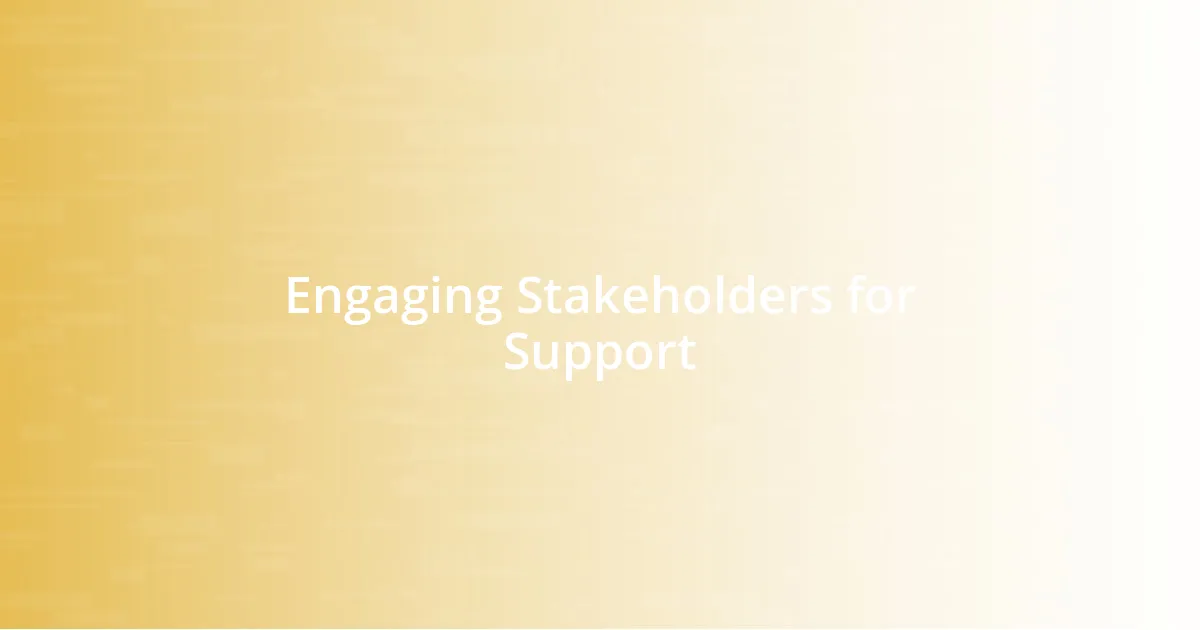Key takeaways:
- Creating a culture of care and accountability is essential for effective safety practices; small adjustments can significantly enhance confidence and empowerment among participants.
- Identifying risks requires ongoing dialogue and thorough assessments of the environment, equipment, procedures, and training to strengthen the safety culture.
- Engaging stakeholders and fostering collaboration builds trust and transforms attitudes towards safety initiatives, enhancing commitment across teams.
- Implementing tailored training and follow-up mentorship reinforces safety understanding and accountability, creating a shared responsibility among employees.

Understanding Safe Practices
Understanding safe practices goes beyond just following rules; it’s about creating a culture of care and accountability. I often think back to a time during a community workshop when I saw firsthand how a small adjustment—like using protective gear—transform the confidence of participants. It struck me hard: safety isn’t just about compliance; it’s about valuing each person’s well-being.
Have you ever noticed how even the smallest details can greatly affect our safety? I once witnessed a colleague make a seemingly minor change in lab protocols, like clearly labeling hazardous materials. That simple act not only avoided potential accidents but also fostered an environment where everyone felt empowered to prioritize safety. It made me realize that safe practices are like the threads in a safety net; each one contributes to the strength of the whole.
Discussing safe practices also leads to a sense of community. I remember the nervousness I felt during my first safety meeting, unsure if my ideas would resonate. However, the open dialogue that followed encouraged everyone to share their experiences, highlighting that safe practices evolve through collaboration. It really made me appreciate that creating safe environments is a collective effort, and inviting others to share their perspectives fosters a deeper understanding of what safety truly means.

Identifying Risks in Practices
Identifying risks in practices requires a keen eye and an open mind. I remember a project I was involved in where we conducted a thorough assessment of our environment. We discovered that something as simple as clutter in workspaces posed a significant risk, affecting both physical safety and productivity. This experience reinforced my belief that risk assessment isn’t just a box to check; it’s an ongoing dialogue about improving our practices.
To identify risks effectively, consider these key aspects:
- Environment: Examine how the physical setup can lead to accidents or errors.
- Equipment: Regularly check if machinery is maintained and safe to use.
- Procedures: Scrutinize if current workflows might inadvertently introduce hazards.
- Training: Ensure everyone is adequately trained to identify and address risks.
- Culture: Foster an environment where everyone feels comfortable discussing potential concerns without fear of judgment.
By addressing these areas, I find that not only are risks minimized, but the overall culture of safety strengthens.

Developing a Safety Advocacy Plan
Developing a comprehensive safety advocacy plan involves setting clear objectives and fostering a collaborative environment. I recall during a safety initiative at my workplace when we gathered input from various departments. This collaborative effort allowed us to pinpoint specific areas for improvement, making everyone feel invested in the safety culture. It reinforced my belief that a successful plan must incorporate diverse perspectives to truly resonate across the organization.
One crucial aspect of my safety advocacy plan focuses on continuous education and training. I often reflect on a workshop I attended where an expert discussed the impact of proper safety training. It was eye-opening to see how participants’ confidence grew as they learned new skills and strategies. This not only changes their approach to safety but also encourages them to take ownership of their well-being, which is essential for a robust safety culture.
Lastly, evaluating and revising the advocacy plan regularly ensures it remains effective. I experienced this firsthand when we set quarterly reviews for our safety measures. Each time, we celebrated successes and identified new challenges, which kept our team motivated and engaged. I find that this cycle of feedback fosters resilience and adaptability within the safety framework, creating a proactive approach to risks.
| Plan Component | Description |
|---|---|
| Objectives | Define clear goals for safety initiatives to align everyone’s efforts. |
| Collaboration | Engage diverse departments for input and shared ownership of safety culture. |
| Training | Implement ongoing education to empower individuals and improve safety skills. |
| Evaluation | Regularly assess and update the plan to respond to new challenges and feedback. |

Engaging Stakeholders for Support
Engaging stakeholders for support is an essential piece of advocating for safe practices. I remember sitting in a meeting with team members, discussing potential changes to our safety protocols. By actively listening and valuing their input, we developed a shared understanding. This unity transformed our approach—it’s amazing how collaborative conversations can ignite a sense of responsibility and commitment across the team, don’t you think?
Building relationships with stakeholders isn’t just about sharing information; it’s about cultivating trust. For instance, when we introduced a new safety initiative, I made it a point to personally follow up with individuals who seemed hesitant. I asked them open-ended questions to uncover their concerns, which ultimately helped us tailor our messaging. Their feedback felt like a breath of fresh air, turning skepticism into enthusiasm.
Moreover, I’ve found that involving stakeholders in hands-on demonstrations can truly make a difference. One time, we organized a workshop where participants could experience the new safety measures firsthand. Observing their reactions—initial discomfort that shifted to excitement as they mastered the new equipment—was priceless. It underscored how meaningful engagement can transform attitudes and foster a supportive environment for safe practices, don’t you agree?

Implementing Training Programs
When it comes to implementing training programs, I’ve witnessed the profound impact of tailored educational sessions. During my time at a manufacturing plant, we rolled out a safety training module specifically designed for each job role. The results were remarkable; employees felt more competent and prepared to handle safety risks unique to their tasks. Doesn’t it make you think about how important it is to speak directly to people’s experiences?
I often recall a training day where we utilized real-life scenarios. By simulating potential hazards, participants could actively engage and practice their responses. This hands-on approach not only alleviated fears but also built a sense of camaraderie among the team. It’s fascinating how training can double as a team-building exercise, forging connections that strengthen our commitment to safety.
Furthermore, I believe follow-up is essential after initial training sessions. We implemented a mentoring system where seasoned staff partnered with newer hires to reinforce safety practices. This not only provided ongoing support but also nurtured a culture of accountability. Have you ever noticed how mentorship can enhance both learning and confidence in applying new skills? It’s truly rewarding to see how consistent training fosters an environment where safety is a shared responsibility.

Measuring Advocacy Impact
Measuring the impact of advocacy efforts can often feel like wandering through a foggy landscape, but I’ve learned there are clear ways to illuminate those outcomes. For instance, after an advocacy campaign for new safety policies, I initiated pre- and post-surveys to gauge employee awareness and engagement. Seeing the shift in responses—from a mere 60% awareness to over 90%—was not just numbers on a page but a reflection of hope and progress. Isn’t it invigorating to witness tangible changes?
Another approach I embraced was tracking incident rates before and after implementing safety measures. I vividly remember reviewing our quarterly reports and realizing that injuries had dropped by 30% following a specific awareness initiative. That decrease wasn’t just a statistic; it represented lives positively impacted and a testament to our collective efforts. Can there be a more gratifying feeling than knowing you contributed to such a significant change?
Qualitative feedback can be equally telling. I recall hosting a focus group where team members shared personal stories of how improved protocols made them feel safer at work. Their heartfelt accounts of enhanced vigilance and confidence deeply resonated with me, revealing that advocacy is not merely about procedures; it’s about transforming mindsets and cultures. Have you felt that same sense of fulfillment when hearing firsthand how your advocacy has touched lives? It truly reinforces the importance of measuring our impact in varied, meaningful ways.

Sustaining Safe Practices Over Time
Sustaining safe practices is much like nurturing a garden; it requires consistent attention and care. I recall a time when we established monthly safety check-ins, which not only kept safety top-of-mind but also encouraged open dialogue among employees. It was inspiring to see how these meetings transformed into forums where team members could share concerns and solutions, reinforcing our collective responsibility for safety. Have you ever experienced that sense of community when you gather to address shared challenges?
In my experience, creating a feedback loop can significantly bolster the ongoing commitment to safety. For instance, I introduced a simple online platform where employees could suggest improvements or report near misses anonymously. This transparency empowered staff to voice their concerns without fear and illuminated areas we’d overlooked. Isn’t it fascinating how listening to others can unveil insights that might otherwise go unnoticed?
Moreover, celebrating successes, no matter how small, plays a critical role in maintaining enthusiasm for safety practices. I remember organizing an annual safety awards ceremony, recognizing individuals and teams who exemplified safe practices. The pride in their eyes spoke volumes about how much they valued safety, turning it into a badge of honor. Do you agree that acknowledging efforts truly reinforces a culture of safety and motivates everyone to keep striving for excellence?















